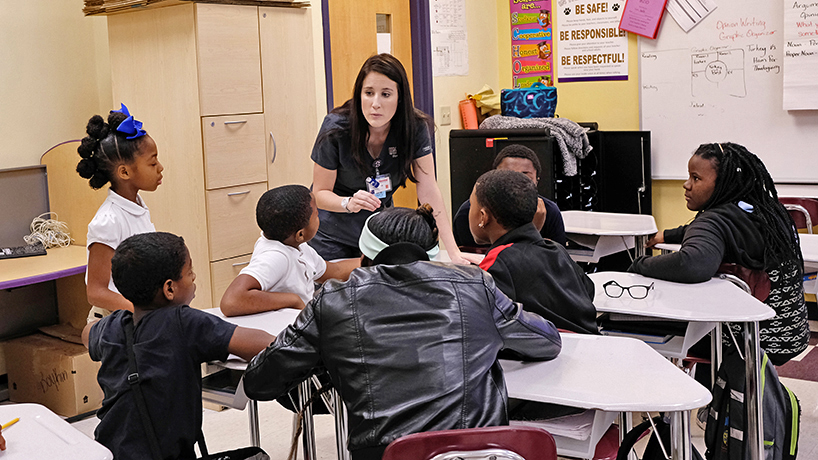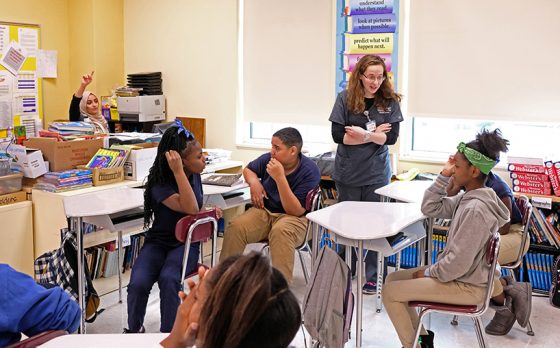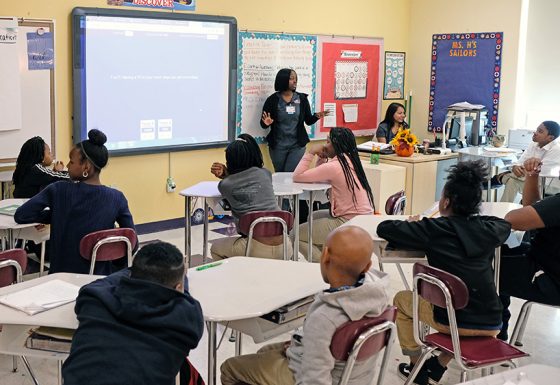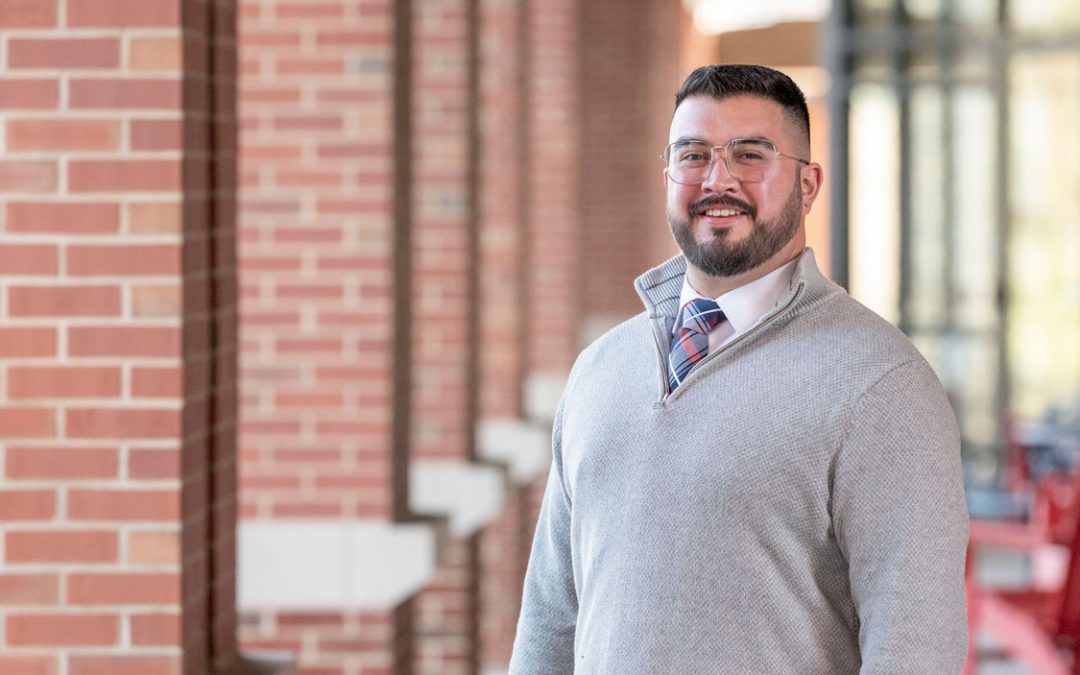
College of Nursing student Skye Mitchell (center) rallies her team for a round of Jeopardy! during a day of service learning at Barack Obama Elementary School. (Photos by August Jennewein)
Only one clue remained on the game board, and answering it correctly was the difference between victory and defeat, so selecting the right contestant became critical for Team 2.
The group of Barack Obama Elementary School fourth-graders conferred and decided: Zachary was their man for Final Jeopardy!
He shot excitedly up to the front of the classroom and whipped off his black acetate glasses. Time to get serious.
His opponent, a tall girl from Team 1, stepped up, and the two stood at attention. In lieu of the traditional signal, University of Missouri–St. Louis senior Skye Mitchell held up a marker. She’d place it on the desk, and whoever grabbed it first would get to respond.
Zachary wasn’t fast enough, but his opponent was flummoxed by the question – “What chemical do you breathe in and what chemical do you breathe out?” – so it went to him. Confidently, he answered oxygen and then paused before going with carbon dioxide.
Correct! He fist pumped and jubilantly danced around the classroom.
This game of Jeopardy! was part of an ongoing College of Nursing service learning initiative at Jefferson and Barack Obama elementary schools. Every semester, the approximately 48 seniors taking pediatric or psychiatric nursing split into groups of two or three and design instructive lessons and games and then try them out on students from first grade up through sixth.

Senior Katherine Sipe (standing) consults with her team while Sajan Alkharabsheh (seated at top left) calls for an answer.
The program kicked off in 2014 when faculty member Kathy Hodgson heard from her colleague Sheila Grigsby that Barack Obama Elementary needed some help. Hodgson got in contact with the school’s counselor, Laverne Ferguson (BSW 1992), and asked what they needed.
“Basically, she said, ‘We need whatever you want to offer,’” Hodgson recalled. “I started taking my pediatrics students there to do physical health classes and my psych students there doing self-esteem, anti-bullying. Two or three years later, we started helping with Red Ribbon Week. It’s drug education, so that kind of crosses pediatrics and psych, so whatever class I would be teaching in October, I would take that group of students there to do drug education.”
Last year, school counselor Susan Grimes reached out and asked if the program could expand to Jefferson Elementary, and Hodgson was happy to oblige. She views the relationship as mutually beneficial and good for the community at large.
“Our students need to know St. Louis,” Hodgson said. “They need to know their neighbors, and we need to contribute to our neighbors so that as nurses we are seen as a positive in their lives.”
The nursing students start the process of designing their lessons by researching their topics and devising age-appropriate activities, which Hodgson or another instructor then approves. Aside from quiz games, role playing and coloring are popular with both sets of students.
“Usually, it’s about a half-hour-long activity, and the instructions are to make it age appropriate, fun and meaningful so that the kids will participate,” Hodgson said. “The last few minutes of the class are geared for the students to evaluate how it did.”
Evaluation was in play in real time during Jeopardy! After each answered question, correct or incorrect, the nursing students interrogated the responses by asking the group why it was right or for opinions on the topic. But the student instructors weren’t only teaching – they were also learning.
“They learn how to manage a group of 20 rowdy kids,” Hodgson said. “They learn how to call on the quiet kids. They learn how to really hear what the little student is saying because they will say some things that will knock your socks off. They learn how to present a topic that’s important in a way that the kids will pay attention and not just shut down, which isn’t all that easy. So, they have to make it fun.”

Pabitra Upreti (seated at top right) and Navonna Smith (standing) led a group of fourth-graders in round of health-education-themed Jeopardy!
They also had to figure out what was developmentally appropriate for each class, which required significant research and preparation. One BSN student, Navonna Smith, created an instructional video that she ran by a family friend who worked in education before trying it out on the elementary students.
“We were unsure what the fourth-graders would know and how sophisticated each age group would be,” BSN student Pabitra Upreti said. “We’re blown away by the knowledge there.”
Part of preparing for the day was developing an appreciation and understanding for the life circumstances of the students.
“You have to watch what you say or can’t say,” senior Sajah Alkharabsheh said. “We were talking about different drinks with the students, and one said, ‘Water is the only thing we can get.’ They didn’t have the financial means for juice.”
Upreti and Smith noted how really listening and understanding the students required patience but was rewarding. Mitchell, who hadn’t been interested in pediatrics previously, said the experience and her rotation made her more open to future possibilities. The nursing students ended their lessons with some moments for questions about health issues, but the elementary school students were more interested in hearing about UMSL. Was it a good place to go to school, and could they study biology there?
“It was good to do something outside of the classroom and the hospital,” Mitchell said. “The students were so excited to see us. They want to be marine biologists, teachers, nurses. They have big dreams, but they might not have many options.”
Upreti added: “Students look at our diverse group and see hope.”














